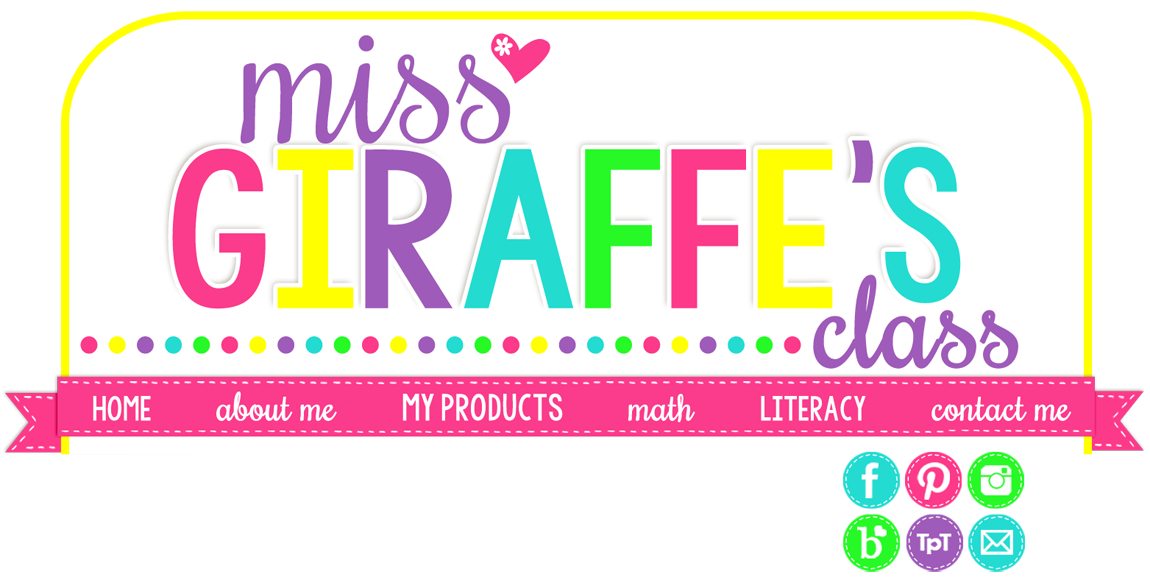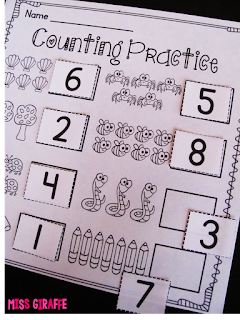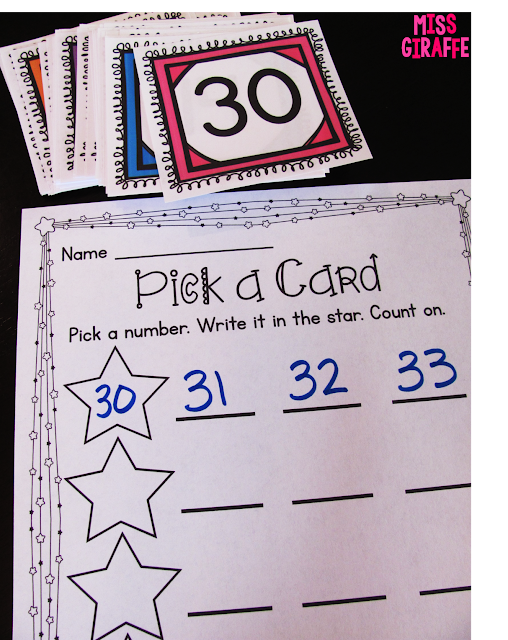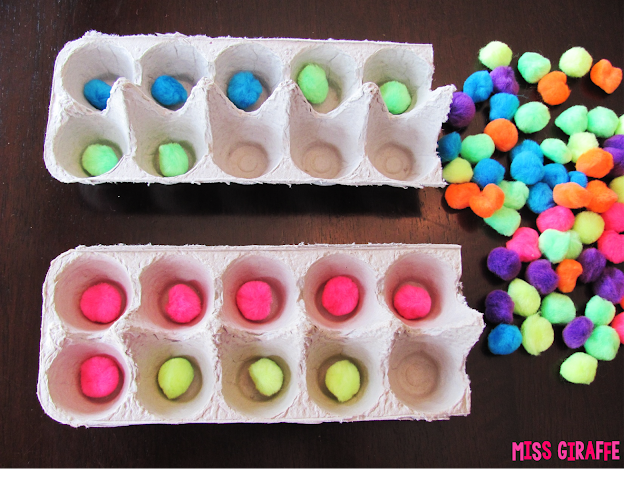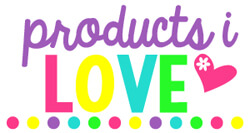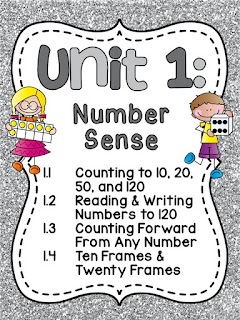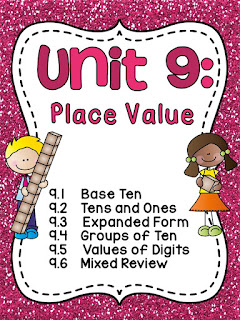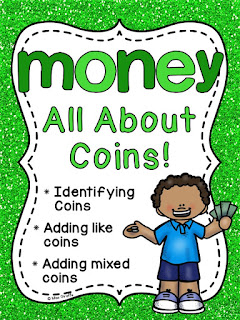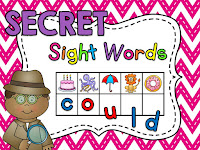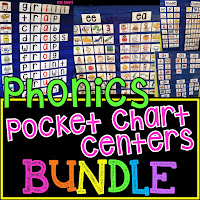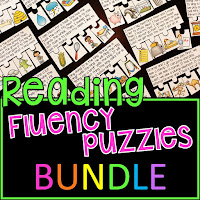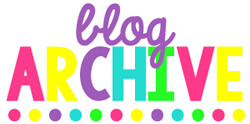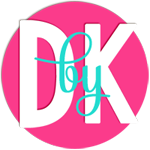One of my favorite things to do for math instruction is paint! Really! An awesome way to practice arrays and repeated addition is to paint them with cotton swabs. I also love using cotton swabs to paint ten frames which I talked about in my big building number sense blog post. Math gets pretty tough in 2nd grade and 3rd grade so the more you can make it hands on and fun, the better! Math becomes a lot more "paper" as they get older so they will pretty much cheer when you bust out the paint!
Speaking of paint, I also love making Array-nbows!!
Have your students paint the arrays into their little grids in ROYGBIV order to make array-nbows! Super cute, right?? Like I said, I love paint! You barely use any when you're painting with cotton swabs so it's nice and cheap.
To first teach arrays or to help your lower students, I really recommend using cubes. The cubes that snap together really show WHAT repeated addition actually is because they're connected in sets.
The cubes will really help them see that 3 x 4 is 4 repeated 3 times. Give them a problem (3x4) and have them build it with cubes at your small group table. Then, have them say, "This is 3 sets of 4 or 4 + 4 + 4 which is 12" or however you want them to represent it. Cool teacher bonus points for letting them write on the table like this with a dry erase marker, but they can build it on a mini dry erase board and write it there too!
Another great way to earn cool teacher bonus points is to use FOOD! Food is the ultimate motivation for learning, it really is... especially when that food is cookies!
For cookie tray arrays, you just need mini chocolate chip cookies and the recording sheet! For a lot of practice, give them a pile of cookies and put the recording sheet in a sheet protector. Have them build several arrays and fill out the bottom each time with a dry erase marker at your small groups table. When they're all done, it's COOKIE TIME! This is a great activity that will get you 100% engagement, let me tell you. Plus you get to eat cookies too (and without judgement! You're clearly the best teacher ever right now - you're teaching with cookies for goodness sakes, you deserve those cookies) so everybody wins. :)
Speaking of baking and such, another really great way to teach arrays is to practice the visual representation with mini muffin pans and pom pom balls! Have students grab a card (ex: 4x4) and fill in their mini muffin tray with pom pom balls to make it.
You can get a mini muffin tray at basically any store that has kitchen stuff. I absolutely love this activity because its hands on, colorful, and really helps solidify the concept.
Another hands on way to practice arrays is with dough! You may remember the way I use dough for learning fractions.. I think it can be used to teach a lot of math concepts, even in 2nd grade, 3rd grade, 4th grade, whatever! They will be so excited to get to play with it because it's probably been a long time since it's regarded as a "little kid" thing. They're still little kids, just in bigger bodies!
Have students take a card and roll the dough up into little balls to build it. So simple but lots of fun and a great way to practice. You could also have them write the repeated addition form and what it equals on a whiteboard or piece of paper for extra practice!
So as if you haven't earned enough cool points with your students yet, bust out some MORE food! Colorful cereal is an easy way to practice! Have students build arrays with cereal. Your choice if you want them to glue it on or eat it!
You could have them write 3x3, 3x3=9, 3+3+3, 3+3+3=9, whatever you want them to practice!
I think it is important for them to be able to match the visual representation of an array to the multiplication representation and repeated addition representation so I made some puzzles to practice that! I make puzzles for just about every math concept so you should've known a puzzle was coming... :)
For this puzzle, students match up the 3 pieces for each array and then record on their recording sheet. This helps bring all of the ways to represent an array together in their minds and great practice writing it as well.
I also have matching cards that you've seen a little bit of already for small groups instruction. It can also easily be a center where they match the types. I made a recording sheet to go with them in case you want to use it as an independent center after they've worked with the cards in small groups.
Another game I love to play with these is MEMORY! Give students as many matching cards in TWO forms as they can handle. It's important you give only 2 representation types for each match or the 3rd one will never match. So let's say you pick the picture representation (bees) and the numeral (6), you leave the 3x2 card out so each card has a match. Have them work in partners, put all the cards upside down, and take turns flipping 2 over at a time... if they match, they keep them. If not, they put them back where they got them and it's their partner's turn. Keep playing until math station time is over or all of the cards are taken. Easy and fun!
Another fun activity you can do is an arrays craft with googly eyes!! This is perfect if you teach arrays around Halloween time but it's really super fun and appropriate any time of the year! For this craft, students need googly eyes and a piece of construction paper - that's it! Have them form an array with their googly eyes and write out their poem!
Instead of "math student, math student," you can have them write their names ("Jayden, Jayden, What do you see?") which would make an adorable bulletin board to display your math learning!
I got my googly eyes and a lot of other supplies at the dollar store, like these circle stickers people typically use for yard sales! There were a little over 300 circle stickers in the pack for only $1 so it's a cheap "craft" activity.
Simply give students the dot stickers and have them build arrays on a sheet of copy paper!
You can also have students use bingo markers to stamp arrays. They love bingo markers! I don't recommend getting them at the dollar store though - the ones I have gotten there are waaay too wet and puddle rather than dab. So many places have them for pretty cheap, just be on the lookout!
BUT a great dollar store find are those cheap checkers sets. Only a dollar, of course, and their flimsiness is actually perfect because they come folded into fourths which makes separating them into four 4x4 boards to build arrays on for practice is super easy! They're 8x8 so 64 squares total - so you can split them up into 4 mini 4x4 boards for basic arrays OR leave it together to practice bigger arrays. You can use absolutely any object to build the arrays. I love seasonal erasers - you can make it match whatever the current season/holiday/theme is. Owls for fall right now! :) I always grab these little packs of erasers 60 for $1 whenever I see them for math manipulatives!
Okay so I also like to make little books for like every math and literacy concept. Books are great because they're fun for students to make and, unlike worksheets, they actually keep them! They take them home and show them off, they reread them, they love them. Books are a great way to review what you've learned and show it off.
This little book is a perfect little review. Each page tells them which array to draw and then they write the repeated addition for it. The book is 8 pages (each page is a half-page like shown) including the cover so it practices 7 different arrays. You can easily take out pages to differentiate for struggling students.
Another book I like to make are my 3 page sorters. They're a book but also a sorting activity and I have them for a lot of different math and literacy concepts in my TpT store. Each of the top pages (3 of them) is what they're sorting under.
So under the 2x2 flap, they'd put the picture representations that match that array on the next page under that. Then, they'd put the next 2x2 picture on the page under that and so on. There are 15 picture representations to sort under each array so each gets 5 pictures under it. They color, cut, sort, and glue! I have many kinder and 1st grade teachers who use all of my little books so trust me, they can do it!
So now you feel like they've got it, they've made crafts and little books to show their learning... now you need math stations for next week to review, right?? Don't worry, I've got you covered!
DICE!
In all my math posts, I talk about how I love to use dice for everything... arrays are no exception!
Have students grab 2 dice and the above recording sheet. Have students roll the dice to figure out what array to draw. For example: If they roll a 4 and a 3, they'll draw a box that is 4x3 and write 4x3 inside of it. You could also have them write the repeated addition version instead.
They can play this a few different ways:
- By themselves and see how many arrays they can squeeze together in their box without any overlap.
- With a partner, take turns rolling the dice and drawing the array in their color. Your goal is to get as many arrays in your color as you can. Maybe you make it a strategy game for your higher students where they try to block each other or something, I don't know! I just know there are a lot of fun ways to play this and your students will probably come up with their own!
To get arrays larger than 6x6 (since dice only go up to 6 - unless you have fancy shmancy numeral dice, that is), you can also use playing cards! Take out the face cards and give them a stack of cards to draw from to make their arrays.
I also have worksheets that look like this where they use the sheet to find all of the arrays that equal 12 and another where they find all the arrays that equal 20 to get them thinking!
I also have a worksheet to practice columns and rows since that is a concept that is helpful for them to know. Simple, straightforward practice or assessment as you can see below.
So do you feel ready to teach arrays now???? I sure hope so! It lays a great foundation for multiplication and really helps students to see the why and I love that!!
If you want to save yourself a boatload of time and grab all of these activities, they're in my Arrays Arrays Arrays pack!!
I will discount it for a limited time in honor of this post so go check it out!
It is HERE: Arrays Arrays Arrays
I already have A LOT of math resources and I'm working on a TON more that I will be posting this summer and school year so be sure to follow me on Teachers Pay Teachers as well so you don't miss out!
Thank you so much for taking the time to read about my arrays ideas!! I hope this post was helpful for you and you feel equipped with a lot of strategies to teach arrays!
Also - don't forget to join Miss Giraffe's Class so you never miss out on fun ideas and exclusive free stuff from me only for subscribers!
If you want to keep up with all the teaching ideas and fun stuff I share, you can follow me in these places too if you want!
Facebook (I often post announcements, new resources, resource updates, ask questions, etc.)
Instagram (I love sharing fun ideas here!)
Bloglovin (to keep up with new blog posts)
You can also check out all my favorite blog posts I've written organized by topic here:
Miss Giraffe Blog Posts List
I share A LOT of teaching tips in those posts so definitely check them out to read more fun ideas! :)
I share A LOT of teaching tips in those posts so definitely check them out to read more fun ideas! :)
